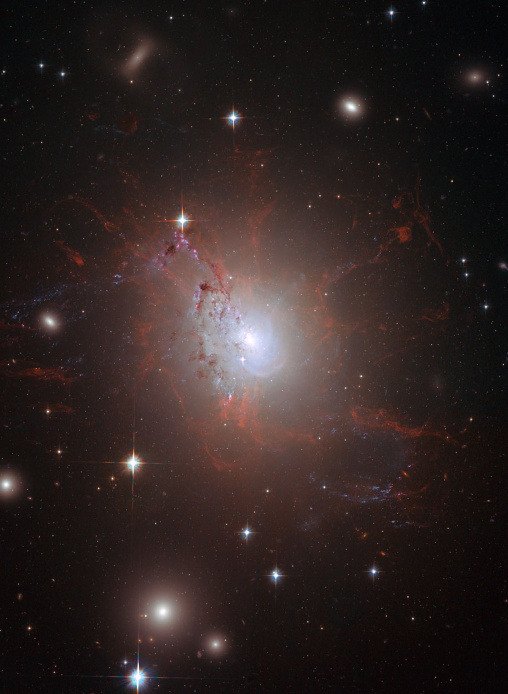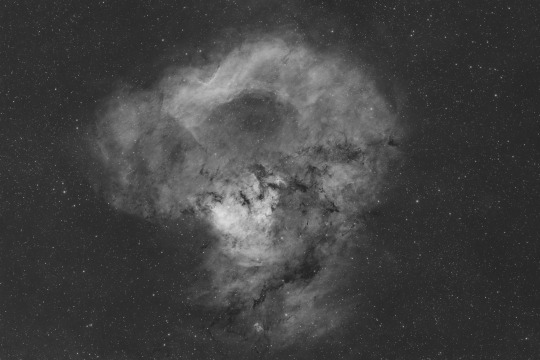#NGC 1275
Explore tagged Tumblr posts
Text

NGC 1275 Core with a black hole © Hubble
#galaxy#ngc 1275#space#hubble telescope#astrophotography#stars#black hole#night sky#solar system#nasa#astronomy#planet#cosmos#universe
904 notes
·
View notes
Text

The Perseus Cluster, Abell 426 // Michael Telesco
#astronomy#astrophotography#galaxy cluster#perseus cluster#Abell 426#galaxy#elliptical galaxy#lenticular galaxy#NGC 1275#perseus
42 notes
·
View notes
Text

6 notes
·
View notes
Text
Magnetic monster NGC 1275

These are reddish lacy structure surrounding the central bright galaxy NGC 1275. These filaments are cool despite being surrounded by gas that is around 55 million degrees Celsius hot. They are suspended in a magnetic field which maintains their structure and demonstrates how energy from the central black hole is transferred to the surrounding gas.
#astronomy#astronomers#universe#nasa photos#nasa#astrophotography#astrophysics#outer space#nasawebb#hubble space telescope#space exploration#space#science#james webb space telescope#the universe#alternate universe#our universe#nasa science#science facts#planetary science#space science#planetary nebula#solar system#i love astronomy#astronomy facts#astronauts#cosmos#space photography#astronaut#nebula
48 notes
·
View notes
Text

First Light with the ZWO ASI2600MM Pro mono camera June and July consistently delivered terrible weather for astronomy. There was one clear-ish night somewhere in the middle of the waves of thunderstorms, torrential rain, and general cloudiness, but there was a nearly full moon, and a few hours of clear skies amid weeks of cloud wasn’t worth it. So I waited for the next opportunity. Last night, August 11th, I set up the Sky-Watcher mount with the William Optics SpaceCat and the new camera.
Here's the result of my first imaging run with the ZWO ASI2600MM Pro mono camera, cooled to -10C, Antlia 3nm Hydrogen-alpha Pro Imaging filter (2 inch). 52 x 300-second sub-exposures with minimal calibration (bias & dark, no flat frames). The ASI2600 is built around the monochrome version of the Sony IMX571 APS-C sized sensor, and although you can get away with 36mm unmounted filters, I went all the way to 2 inch mounted narrowband filters. And not even a hint of vignetting. I didn't use flat frames when stacking. So, am I impressed with the ZWO ASI2600MM Pro? Oh yeah.
I started narrowband imaging about ten years ago with Atik mono CCD cameras, moved through a couple QHYs, and settled on the ZWO ASI1600MM Pro—the smaller, older generation of this ASI2600. I've been using the 1600 for four or five years, and it was time to upgrade. The 2600 has been out for a little while—I'm not new to this camera but I'm really glad I made the jump.
Target Notes: NGC 7822, Cederblad 214, SH2-171 (the brighter emission nebula core) as well as the star cluster Berkeley 59. There are several long chains of clumps of dark nebulae, including LDN 1268, 1275, Dob 3637, 3627, 3623, many more. Nestled in that large band of dark nebulae toward the bottom is the reflection nebula GN 23.56.1. The very small circle of gray at the top left, blending in but dimmer than the nearby stars, with less contrast, is the planetary nebula Abell 1 (PLN 119+6.1). Find all of this—the nebulae and star forming complex in Cepheus near the edge of Cassiopeia.
3 notes
·
View notes
Text
Oh, what's this post going to be about? A scrapped idea of mine? That's new.
I never intended to make 42 an active hunter, but before I came up with the "street vulture" lifestyle it has, I've been thinking about...a kinda weird alternative. I...somewhat wanted to connect 42 and Chester somehow for whatever reason some time ago. So I was like: "What if these two have some "symbiotic" relationships?" Although another question or, rather, questions were: "How the heck would they meet? How wouldn't one just become prey for another? How would the hippie man get the meat for 42, while the doppel gave him its protection, because, again, 42 would find Chester curious later on?"

Pinwheel Galaxy
I remember the thought of one Youtuber: "What If he (Chester) is some sort of a doppelganger as well?" But Nacho confirmed he's actually a human. The developer also said something like: "He may or may not be a time traveller". So Chester, probably, wouldn't need that from 42.
Then there's the Nightmare mode, where both are present, with Chester becoming a Nightmare version of himself. Although he seems to behave as usual. He just has tougher questions. And 42...

NGC 2207 (left) and IC 2163 (right) - the colliding spiral galaxies.
...well, I'm yet to think what it is doing there, being a VIP. I heard a thing that, apparently, people cannot dream about the things or entities which they didn't see in reality. Yet 42 doesn't really pay doormen a visit. What if it spaces out because its own mind goes to whoever is "playing" the mode and has it as a VIP? I still don't know what it'd be doing there and why, though...

NGC 1275 or Perseus A Galaxy
Another "if you read up to this point" fact:
I once thought of making a Chester blog, but I wasn't too confident about it. Maybe, it's temporary, maybe not, but, again, I'm spilling my thoughts. At least gradually, piece by piece. Even if they may not be understood by anyone, including me.
1 note
·
View note
Text
0 notes
Photo

Peculiar Galaxy in Perseus
38 notes
·
View notes
Photo

NGC 1275
#NGC 1275#nasa#stargazing#astrophoto#astrophotography#galaxy#astronomy#universe#space#nebula#spinningblueball#thespinningblueball#milky way#milky way galaxy#milkywaygalaxy#spacephotography#nightsky#starrynight#milkywayphotography#astrophotos#starscape#star#cosmos#telescope#hubble#chandra#spitzer#hubble telescope#chandra telescope#spitzer telescope
99 notes
·
View notes
Photo

NGC1275
This image shows a deep Hydrogen-alpha image of the brightest X-ray source in the sky, NGC1275, taken by the WIYN 3.5-meter telescope at Kitt Peak National Observatory near Tucson, AZ, in 1999.
The filaments emanating from this galaxy are produced through largely unknown mechanisms, but they likely are the result of an interaction between the black hole in the center of the galaxy and the intracluster medium surrounding it. (The glowing background objects in this image are galaxies in that same galaxy cluster.)
At a distance of about 230 million light-years, this is the nearest example to Earth of such vast structures, which are seen surrounding the most massive galaxies throughout the Universe.
credit line: C. Conselice/Caltech and WIYN/NOAO/AURA/NSF
NOAO
13 notes
·
View notes
Photo

Filaments of Active Galaxy NGC 1275
What keeps these filaments attached to this galaxy? The filaments persist in NGC 1275 even though the turmoil of galactic collisions should destroy them. First, active galaxy NGC 1275 is the central, dominant member of the large and relatively nearby Perseus Cluster of Galaxies. Wild-looking at visible wavelengths, the active galaxy is also a prodigious source of x-rays and radio emission. NGC 1275 accretes matter as entire galaxies fall into it, ultimately feeding a supermassive black hole at the galaxy's core. This composite image, recreated from archival Hubble Space Telescope data, highlights the resulting galactic debris and filaments of glowing gas, some up to 20,000 light-years long. Observations indicate that the structures, pushed out from the galaxy's center by the black hole's activity, are held together by magnetic fields. Also known as Perseus A, NGC 1275 spans over 100,000 light years and lies about 230 million light years away.
Credit: Hubble Legacy Archive, ESA, NASA; Processing & Copyright: Domingo Pestana
#astronomy#space#cosmos#universe#astrophotography#cosmology#science#NGC 1275#galaxy#active galaxy#Perseus A
265 notes
·
View notes
Text

Playing around with pixelmath in PixInsight with my narrowband data of NGC 7822, Cederblad 214, an emission nebula in Cepheus, about 3,000 lightyears away. This is Hydrogen-alpha (Ha) combined with Oxygen 3 (OIII) data I captured over several weeks, made up of 52 x 300-second exposures of Ha and 32 x 600-second (10 minute) exposures of OIII. Gear notes: #WilliamOptics Space Cat 51 (250mm FL @ f/4.9), #ZWO ASI2600MM-Pro monochrome camera cooled to -10C, Sky-Watcher EQ6-R Pro mount, William Optics 32mm/120mm FL guide scope + ZWO ASI290MM-Mini guide camera.
Target Notes: NGC 7822, Cederblad 214, SH2-171 (the brighter emission nebula core) as well as the star cluster Berkeley 59. There are several long chains and clumps of dark nebulae, including LDN 1268, 1275, Dob 3637, 3627, 3623, many more. Nestled in that large band of dark nebulae toward the bottom is the reflection nebula GN 23.56.1. The very small circle of gray at the top left, blending in but dimmer than the nearby stars, with less contrast, is the planetary nebula Abell 1 (PLN 119+6.1). Find all of this—the nebulae and star forming complex in Cepheus near the edge of Cassiopeia.
0 notes
Photo

(Hubble) Magnetic monster NGC 1275
This stunning image of NGC 1275 was taken using the NASA/ESA Hubble Space Telescope's Advanced Camera for Surveys in July and August 2006. It provides amazing detail and resolution of the fragile filamentary structures, which show up as a reddish lacy structure surrounding the central bright galaxy NGC 1275. These filaments are cool despite being surrounded by gas that is around 55 million degrees Celsius hot. They are suspended in a magnetic field which maintains their structure and demonstrates how energy from the central black hole is transferred to the surrounding gas.
By observing the filamentary structure, astronomers were, for the first time, able to estimate the magnetic field's strength. Using this information they demonstrated how the extragalactic magnetic fields have maintained the structure of the filaments against collapse caused by either gravitational forces or the violence of the surrounding cluster during their 100-million-year lifetime.
This is the first time astronomers have been able to differentiate the individual threads making up such filaments to this degree. Astonishingly, they distinguished threads a mere 200 light-years across. By contrast, the filaments seen here can be a gaping 200 000 light-years long. The entire image is approximately 260 000 light-years across.
Also seen in the image are impressive lanes of dust from a separate spiral galaxy. It lies partly in front of the giant elliptical central cluster galaxy and has been completed disrupted by the tidal gravitational forces within the galaxy cluster. Several striking filaments of blue newborn stars are seen crossing the image.
Credit: NASA, ESA and Andy Fabian (University of Cambridge, UK)
Source
3 notes
·
View notes
Photo

Active Galaxy NGC 1275 #NASA https://ift.tt/rPqxJZk
0 notes
Photo
Awesome! So it's making a galaxy or like it's building itself?

Filaments of Active Galaxy NGC 1275
#space#galaxy#nebula#universe#astronomy#science#filaments#active galaxy#NGC 1275#cool#bright new stars#it was worth it tngbabe#😎
492 notes
·
View notes
Photo

NGC 1275, Star Streams
#Astronomy#NASA#Night#Sky#Stars#Space#Science#Universe#Cosmos#Cosmic#Solar System#Star#Streams#Galaxy#Nebula#Constellations#Constellation#Rainbow#Bright
1K notes
·
View notes